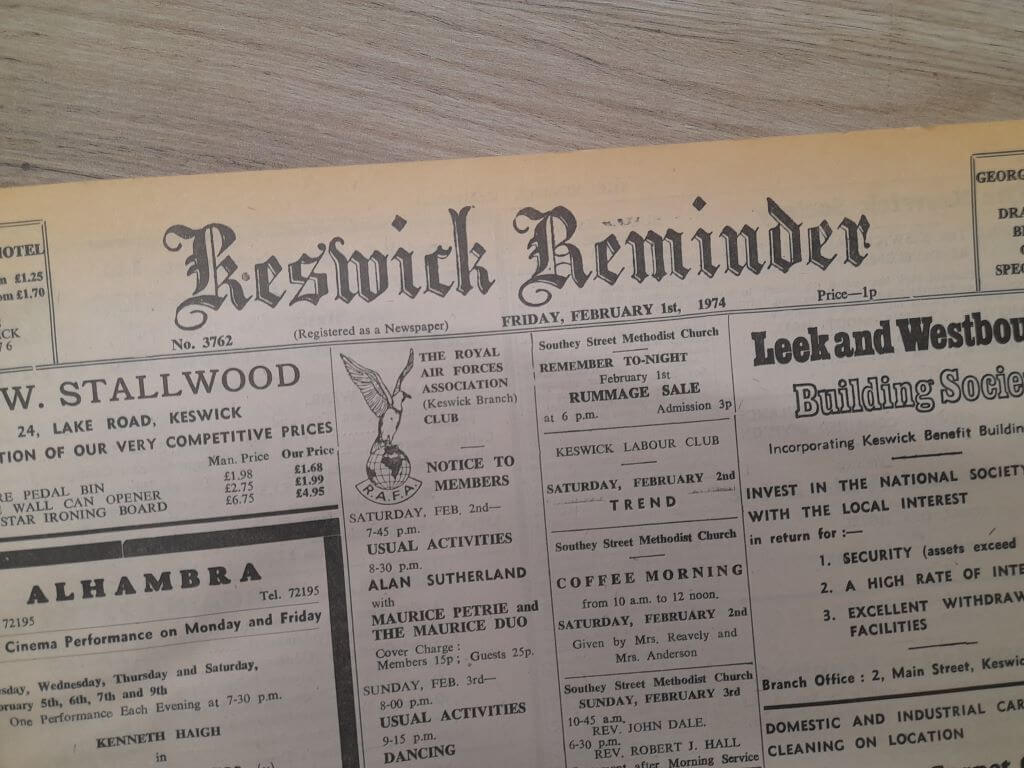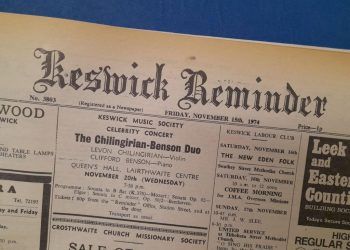
Looking back through the archives of The Keswick Reminder from around this week 20, 30 and 40 years ago.
20 years ago
Changes for local hotel
There are few hotels that have a world famous reputation, but the Lodore Hotel in the Borrowdale Valley near Keswick is one such establishment. The Hilton Keswick Lodore Hotel, as it is currently known, is in the midst of an imminent takeover bid by local hoteliers.
The Graves family of West Cumbria, who already own several leading hotels in the county, including the Armathwaite Hall near Bassenthwaite, the Skiddaw and King’s Arms Hotels in the centre of Keswick, and the Inn on the Lake at Ullswater, are set to buy the Lodore Hotel from the international Hilton group.
Director Carolyn Graves confirmed earlier this week that talks with the Hilton group were ongoing but was unable to give any further details at this stage. She said, however, that more information about the deal would be available in the next week or two.
The 70 bedroom hotel had an international reputation for good food and personal service when, for many years, it was run by the England family. It has hosted a number of celebrity guests including the likes of Sir Cliff Richard who enlisted some local tennis opponents when he was staying in the Keswick are on a filming trip, and also John Major when he was Prime Minister.
30 years ago
New rescue team leader
Keswick Mountain Rescue Team, one of the busiest in the Lake District, has a new leader. Mark Hodgson has taken over from Mike Nixon, who has led the team for the past twelve years.
Mark, the elder son of Mr. and Mrs. David Hodgson of Greta Lodge, Keswick, first joined the Keswick Mountain Rescue Team as a teenager. He is contracts manager for Eden Construction and is a keen climber and fell walker who has a twenty year link with the Team.
His predecessor, Mike Nixon, took over the leadership from George Fisher, who was leader from the early days of the foundation of the Rescue Team. Mike was partly responsible for Mark Hodgson becoming involved with the work of the Team.
Thirty-eight year old Mark recalls: “I first got involved when I was 17 and still in the scouts. As part of the chief scout’s award I had to undertake some voluntary service helping others and the Rescue Team seemed a very good choice as another factor was that my uncle, Mike Nixon, was a member.”
40 years ago

Approaches to Eden
Keswick Town Council are to make official approaches to neighbouring Eden District to find out the implications of becoming part of that authority. And once the information is to hand they plan to call a public meeting in Keswick to find out what local people think.
At Thursday night’s Council meeting the Mayor, Councillor Martin Jordan, announced the intention to approach Eden District Council.
He said the Town Council’s Management Committee were also planning to arrange a meeting with Allerdale Council “to discuss their future plans for Keswick and district.”
The Town Council are also to seek talks with the bordering Parish Councils of St. John’s, Borrowdale, Above Derwent and Underskiddaw to put them in the picture when they get the information from Eden.
News that Keswick Councillors were holding private meetings to consider the implications of a transfer to Eden and withdrawal from Allerdale Council were first revealed two weeks ago.
The move follows a rising wave of dissatisfaction in Keswick about the relationship with Allerdale and was brought to a head by recent controversies over car park charges and lack of financial support for tourism.
Warship plaque
A fading copper plaque in Keswick Council Offices bears testimony to the time when the town raised £120,000 to send a destroyer to war.
In a “Warship Week” in March of 1942, the town made its final push to finance the Hunt class destroyer H.M.S. Blencathra. And now the plaque, which was presented to the old Urban Council when the warship was de-commissioned, is to be handed over to members of the H.M.S. Blencathra Association.
Council records show that special events during Warship Week included a dance in the Royal Oak Hotel to the Mayfair Blues Special Band, for which admission was 5 shillings, a schools soccer cup on Walker Park and an exhibition in Lower Fitz Park. The amateur judging competition at the dog show was won by Fred Mills of Threlkeld.
The general secretary of the Warship Week effort was the late Mr. Arthur Henderson, former Urban Council clerk.
Old cuttings from the “Reminder” lodged in the Council files state that H.M.S. Blencathra was “adopted by the people of Keswick and District.”
No-one connected with present day Town Council knows what became of the destroyer once she was de-commissioned, but members agreed this week to return the plaque to the Blencathra Association with the proviso that if the Association is ever disbanded it will be returned to the Council’s keeping.
50 years ago

Mr. Tom Standing
After twenty-six years in charge of Keswick ambulance, Mr. Tom Standing, Newlands Vicarage, retired on Thursday and in appreciation of his work, in particular his assistance to the staff of the Keswick Hospital, a presentation was made to him at the annual staff party of the hospital.
Dr. J. A. Harrow presented Mr. Standing with an adjustable height table and a transistor radio and in expressing thanks Mr. Standing said he had always tried to give his best.
Mr. Standing became ambulance driver/attendant for, he thought, only a temporary period, when the ambulance service was taken over from the Urban Council by the National Health Service in 1948. Since then he has travelled many thousands of miles with the ambulance, being available at all times of the day and night and accompanied at nights or week-days by members of the St. John Ambulance service, the two members taking this duty most often being the late Mr. J. W. Eggleston, superintendent of the Keswick Brigade for many years, and Sgt. H. Hartley. The service has now been superseded by the new full-time ambulance station in Penrith Road.
Bell Close
For the past two years Bell Close has been the centre of argument and controversy. It has been the subject of a Public Enquiry, and of much speculation among Councillors, the Keswick Society and the general public. And it would seem that there is some confusion over the question of whether it is necessary to lose all or only part of Bell Close.
That part of the Close which was left on the “island” created between the new road improvement and the old road has now been knocked down – it is too late to have second thoughts, or to try to decide whether this was necessary or not.
But the rest of Bell Close is still standing, and for how long must surely in some part depend on us, the people of Keswick. We must decide quickly whether we really think it absolutely necessary for the buildings between the Main Street and Bell Close to go, leaving Keswick like a “Wild West” town with one main street flanked by car parks.
Would it perhaps be possible to leave the old road as a “service” road, to leave the buildings, and to create small shopping arcades out of the old yards? This would, of course, cost a certain amount of money, but the cost may not be more than the cost of compensation and demolition, and the result would be far more in keeping with this small Lakeland market town.
When town’s lost link to warship surfaced in Essex
In a postscript to the above warship plaque article from 1984, readers may remember the curious tale of how the HMS Blencathra plaque was discovered in an attic 300 miles away in 2014.
Keswick Town Council received a letter out of the blue from a woman saying she had found it at her new home in Essex.
The plaque bears the following inscription: “HMS Blencathra – This ship was adopted by the people of Keswick & District – Warships Week 1942.” There is also the town council’s crest and motto, written in Latin, which means: “The mountains from whence cometh my help.”
By a strange quirk, the woman from Essex had come forward just a few weeks after the Imperial War Museum had written to the town council asking if it knew where either this plaque or HMS Blencathra’s official adoption plaque were located so they could be included in its War Memorial Archive.
In a report from the Reminder on April 18, 2014, town council clerk Lynda Walker said: “It was really weird. Two weeks ago, I received a letter from a lady who had just acquired a house in Essex and found a plaque stored in the roof with a photocopy of a letter from Keswick Town Clerk dated 27 January 1984 agreeing to let the (HMS Blencathra) Association have custody of the plaque, provided they guaranteed to return it should the Association be disbanded.
“I have been advised that the pane could have been held by HMS Blencathra Association until they disbanded and is the commemorative plaque presented by the town to the ship, which after the war would have been returned to the naval stores in Devonport. After the war, many of these plaques were returned to the adopting area and it would appear that this one was returned to Keswick UDC (Urban District Council) in 1948 and then lent to the Association.”
The following week the Reminder reported how the ship’s official badge had been found for sale on ebay, with the town council agreeing to pay the £185 ‘buy now’ price. The intention was for both the plaque and the badge to go on display at Keswick Museum. They remain there today, though currently in storage.
HMS Blencathra was a Royal Navy Hunt-class destroyer which was in commission from 1940 to 1948. She saw service through most of the Second World War receiving battle honours for the North Sea, Mediterranean and English Channel – including famous operations at Sicily and Normandy. Built at Cammell Laird shipyard in Birkenhead, the ship had been ordered under the 1939 War Emergency Build Programme. Her postwar life was uneventful, being decommissioned and placed in reserve in 1948. A proposed sale to Norway in 1950 never came to fruition. Blencathra was put on the disposal list with nine of her sister ships in 1956 and was scrapped in Barrow in 1957.
The ship’s local links with Cumberland and the Blencathra Hunt included its badge, which featured a hunting horn. Research has also shown that Captain Peter Gerald Charles Dickens, who died in 1987 and who was a great-grandson of writer Charles Dickens, was commanding officer of HMS Blencathra from April 1944 to July 1945.








